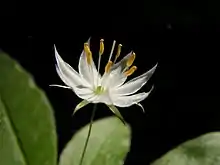Lysimachia borealis
Lysimachia borealis (synonym Trientalis borealis), the starflower, is a North American woodland perennial that blooms between May and June.[2][3]
| Lysimachia borealis | |
|---|---|
.JPG.webp) | |
| Scientific classification | |
| Kingdom: | Plantae |
| Clade: | Tracheophytes |
| Clade: | Angiosperms |
| Clade: | Eudicots |
| Clade: | Asterids |
| Order: | Ericales |
| Family: | Primulaceae |
| Genus: | Lysimachia |
| Species: | L. borealis |
| Binomial name | |
| Lysimachia borealis (Raf.) U.Manns & Anderb. | |
| Synonyms[1] | |
| |
Description

Starflowers have creeping rhizomes with 5–20 cm (2.0–7.9 in) vertical stalks. Each stalk has a whorl of 5–10 lanceolate leaves (up to 8 cm long) at its tip, with 1-4 (most often one or two) white flowers on smaller stalks extending from the center of the whorl. The flowers are about 15 mm (1⁄2 in) across and consist of five to nine petals that form a star-like shape. Its fruit is tiny, globe-shaped, pale blue, and matte.[4][5]
Distribution and habitat
Lysimachia borealis is found from Canada to north-central and eastern United States. It is found in temperate climates.[6]
Conservation status
The starflower is listed as endangered by Georgia and Kentucky and is listed as threatened by Illinois and Tennessee.[7]
References
- "Lysimachia borealis (Raf.) U.Manns & Anderb". Plants of the World Online. Royal Botanical Gardens Kew. Retrieved 13 December 2019.
- VASCAN, Canadensys
- USDA, NRCS (n.d.). "Trientalis borealis". The PLANTS Database (plants.usda.gov). Greensboro, North Carolina: National Plant Data Team. Retrieved 15 December 2015.
- Trientalis borealis Northern Starflower Retrieved 3 November 2017.
- Leboeuf, Michel (2016). Arbres et plantes forestières du Québec et des Maritimes (in French) (Revised and augmented ed.). Canada: Éditions Michel Quintin. p. 279. ISBN 978-2-89762-097-4.
- "Lysimachia borealis". Plants of the World Online. Royal Botanic Gardens, Kew. Retrieved 26 June 2023.
- Trientalis borealis Raf. ssp. borealis USDA Retrieved 3 November 2017.
- Northern Starflower, borealforest.org
- Wildflowers of Minnesota's Northwoods pamphlet, 1999, Minnesota DNR